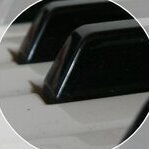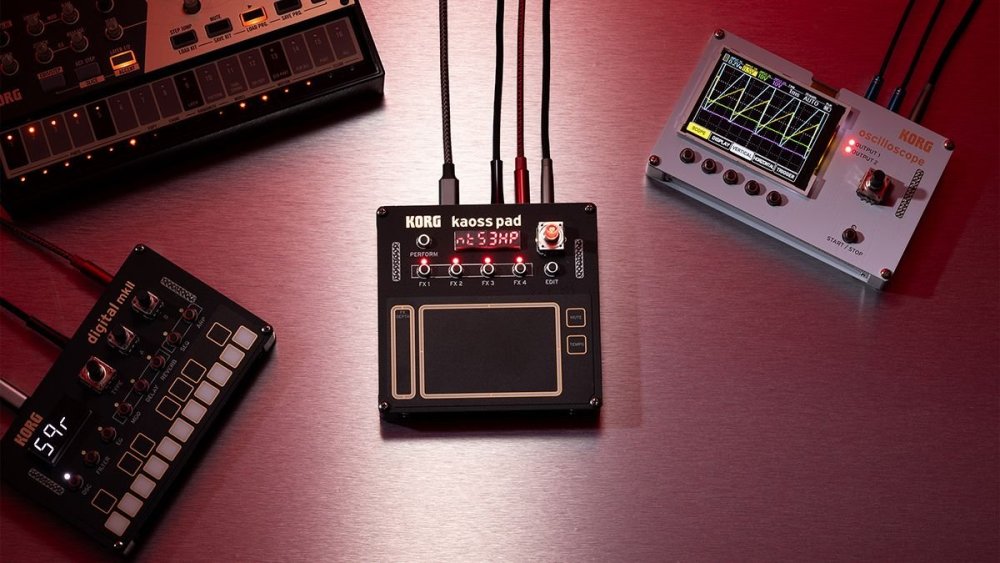Search the Community
Showing results for 'NAMM 2019'.
-
I think what it comes down to (for me) is what a work is vs. what it's being presented as. I thank T Boog for sharing just how wronged a fan can feel, even decades later, upon finding out that they had been misled about exactly whose work they were consuming. From the start of my music fandom, the genres I've been into weren't as much about the appreciation of a certain player's technical prowess as 80's metal. I didn't usually even know who played what. But now I get how if you're presenting your music as having been played by the people in your band, and their technical prowess is hyped as a way to sell records, and they become your heroes and influences, that it could feel like your trust was violated and exploited. Music is important to a lot of people, especially teenagers in their formative years who are looking for role models. Daft Punk's "Digital Love" is one of my favorite songs of all time. When it came out, an anime fan friend of mine told me about it, that they had worked with the guy who did Space Battleship Yamato/Star Blazers on the video, so I found it online and checked it out. I was almost 40, had just bought my house, and I still choke up when I remember how I was emotionally transported back in time 30 years to the time when I loved The Archies, Josie and the Pussycats, The Banana Splits, etc. Also Supertramp a few years after that. There's a video that breaks down where most of the samples they used came from, and when I first watched it, I admit I was initially a bit taken aback by just how much of the song was based on/assembled from other people's recordings. It inspired me to take a look at my own notions about such things and to ease up. Bottom line is that they didn't sell the record as being anything else. They were a pair of friendly robots consuming what they heard and reassembling it to make their own music. That was their product, and it was/is amazing. If a song could make a middle-aged man feel like he was 8 years old again, who CARES where the individual ideas came from? I still have ego problems about using mostly presets for all of the synths (and creative FX) I own. But I had a conversation with Lorene "Produce Aisle" about that when I was doing a remix of one of her songs and she put into perspective with a cooking analogy: do you have to grow all of your own spices in order to be an "authentic" chef? Heck, the top chefs in the most prominent restaurants don't even usually do any actual cooking. @Rain, I hear ya about being a guitarist and feeling like using something other than my own carefully crafted guitar tone is also "cheating." I used to have my own one-person boutique stompbox company, as well as having designed a tube amp on commission that was shown at NAMM. So using "in the box" amp sims makes me feel a bit icky. But y'know, whatever I use, in the end it will still be a tone choice I made (or in your case agreed to), and more importantly, my playing reacting in real time to what I'm hearing. And we gotta serve the songs more than we protect our own egos, right? That's what I hear, anyway.😄 Good analogy about Michelangelo. No matter whose hands crafted how much of it, if the true creative force was in charge, it's a Michelangelo, or Warhol, or Walt Disney, or Hayao Miyazaki. I still do find it kinda weird that The Beatles had someone else do the leads on a song that George Harrison wrote about playing guitar....😏
-

Where is the rollback installer for the last (stable) version?
Will. replied to Aaron Doss's topic in Cakewalk Sonar
You say what? Research will show otherwise. That X1 period 2009 - it was found everywhere. Cakewalk won NAMM that year. -

Where is the rollback installer for the last (stable) version?
Will. replied to Aaron Doss's topic in Cakewalk Sonar
Look up their notes. 2016 Splat was still on it, and 2024 not anymore. Cakewalk used to be mainstream, but I guess when something becomes free it is not considered as "mainstream" any longer. So - The human species often sees and renders something as such, not worth investing time fixing bugs for a "free" product - isnt that how business works? And just like any other product that suffered some bruises - Its tough and takes time to rebuilding your reputation as a brand. It was sad not seeing a table at NAMM. -
Microsoft has released a new Windows 11 Canary build for Windows Insiders. Build 27788 is now available for download with fully rewritten MIDI services, ... https://www.neowin.net/news/windows-11-canary-build-27788-adds-reworked-midi-services-new-onedrive-features-and-more/ Cakewalk has previously worked with Microsoft on cutting edge audio issues. Wonder how much Bandland/Cakewalk is in the loop with this set of developments? Here an excerpt from the changelog: Windows MIDI Services Public Preview We’re excited to release the first in-box public preview of Windows MIDI Services, our complete rewrite of MIDI on Windows with a focus on a great experience for musicians and a strong foundation for future expansion and enhancement. MIDI is the standard, first released in 1983, that is used to synchronize synthesizers and drum machines in almost all modern electronic music. It’s used to record and play back note information, control stage lights and effects, keep mixers in a large venue in sync, and so much more. Although it is not itself audio, the MIDI protocol is essential to making music and was heavily used in the rise of hip-hop and other genres. MIDI 2.0 is the first major update to the core MIDI protocol since 1983, offering everything that modern musicians need today, like increased speed and fidelity, better control of instruments, modern bi-directional conversations and negotiation between instruments, discovery, better USB timing, and more. Windows MIDI Services is our new MIDI stack which handles not only MIDI 2.0 but also brings our MIDI 1.0 implementation up to modern expectations. It works on 64-bit operating systems on all supported processors, including Arm64. Windows MIDI Services offers the following benefits: Full support of the MIDI 2.0 Standard, including high-speed data transmission, higher-fidelity messages, increased resolution for controller values, and full in-service MIDI 2.0 endpoint discovery and protocol negotiation. Faster transports, leading to better timing and reduced jitter. Faster USB MIDI driver with full support for both MIDI 1.0 and MIDI 2.0. Every endpoint is now multi-client, meaning multiple apps can use a device at the same time. Better endpoint and port In-service scheduling of outgoing timestamped messages, and timestamped incoming messages, for apps using the new Windows MIDI Services App SDK. Built-in loopback and app-to-app MIDI Automatic translation between MIDI 1.0 and MIDI 2.0 based on API, application, and device needs. Much more device metadata available to applications. Better device add/update/remove notifications. Backwards compatibility with our WinMM (MME) MIDI 1.0 API (and WinRT MIDI 1.0 in the future) enabling applications to light up with new features without any changes, and even access MIDI 2.0 devices at a MIDI 1.0 feature level. Open source. The MIDI Service, all its transports, all the tools, the tests, and the SDK are all MIT-licensed open source, and have been developed in concert with hardware and software partners around the world. New USB MIDI 2.0 Class Driver: The new USB MIDI 2.0 Class Driver, graciously provided to Microsoft by AMEI (Association of Musical Electronics Industry of Japan) and written by AmeNote, is a high-speed USB MIDI driver which works with both the new USB MIDI 2.0 devices, as well as with class-compliant USB MIDI 1.0 devices. By default, for compatibility, this is enabled only for USB MIDI 2.0 devices and a handful of USB MIDI 1.0 devices. However, you may manually assign this driver to any class-compliant USB MIDI 1.0 device yourself to gain the better transfer mechanisms. We also have several built-in transports for things that were not previously available without third-party drivers. Learn more about the built-in transports here. Windows MIDI Services App SDK and Tools: Applications using Windows MIDI Services do so through the Windows MIDI Services App SDK, shipped out-of-band. Current preview releases are available on our GitHub repo releases page. Please note that these are unsigned releases and so will give you a warning when you download and install. In addition to installing the required runtime components, the SDK runtime installer includes these tools: Windows MIDI Services Console (midi.exe): The all-around console tool for sending messages, checking the state of MIDI, monitoring incoming messages, sending System Exclusive, and much more. MIDI Diagnostics (mididiag.exe): A tech support tool which provides information about the state of MIDI on the PC. MIDI Kernel Streaming Endpoint Info (midiksinfo.exe): A hardware developer-focused tool which provides information about the KS (Kernel Streaming) endpoints. MIDI multicast dynamic DNS Info (midimdnsinfo.exe): A tool to support the upcoming Network MIDI 2.0 transport. The Windows MIDI Services App SDK also includes the MIDI Settings app – a desktop application for managing endpoints, renaming endpoints and ports, creating loopback devices, managing your network MIDI 2.0 connections, and more. In addition, we’re currently working on our Network MIDI 2.0 transport, recently demonstrated at the NAMM Show in California, the virtual patch-bay to enable routing between endpoints, and a rewrite of our BLE MIDI 1.0 transport. This will all ship in a future version of Windows MIDI Services. We look forward to having Windows Insiders who dabble in music creation try out the Windows MIDI Services Public Preview and MIDI 2.0. Try out using existing applications that use the WinMM MIDI 1.0 function with the new Windows MIDI Services installed. Additionally, any MIDI 1.0 devices with specific IHV drivers. You can also join the discussion here on Discord if you have questions or are looking to help! You will find a list of known issues documented here.
-

Differences Between Sonar & Cakewalk by Bandlab
John Faughey replied to Jerry Gerber's topic in Cakewalk Sonar
I think they are doing a great job with the new Sonar. For me the workflow is on point. I have used a few other DAW’s, but I always quickly returned to cakewalk (now Sonar) I was taught on ProTools, but the constant updates and pricing is insane. Studio One is the closest to Cakewalk I have found. Luna looks amazing, but the workflow is not quite there yet for me. So, for me, spending a few bucks on Sonar is not that big of a deal. and i hope they start to add a bit more eye candy.. As for the future, I am hopeful..LOL I said the same thing with Gibson…. I would have felt a bit better if they would have had some sort of footprint at NAMM this year, but they are so lacking in social media I have no idea if they are doing anything. The DAW is really fantastic, and they are missing a huge opportunity in my opinion. -
The big problem is Cakewalk I just got the 16 and it's not working the way it should right out of the box so I been reading post back to 2019 Well what the hell has Cakewalk and Presonus been doing for 6 years You should not have to type anything anywhere to make it happen I'm about to go the NAMM Show this week and Cakewalk and Presonus beware the questions are coming Please have the friggen answers!!!!!!!
-

Andrew Scheps on Mixing with Headphones
bitflipper replied to bitflipper's topic in The Coffee House
I didn't know those were so cheap! The only time I've heard them was at the Sony booth at NAMM, c. 2008. They sounded wonderful. At the time they were a new product, and when I asked the rep what they retailed for, he said $500. I set them back on the rack and moved on. -
In my initial post, I had typed "no VSL suggestions, I can't justify that kind of money". But then deleted that line before posting. I didn't want to influence anyone's suggestions by eliminating anything up front. The first time I heard VSL was at NAMM in 2008. I walked into their booth and was almost lifted off my feet by what I heard. My first question was why the VSL patches that came with the Kontakt factory library didn't sound anywhere near that good. My second question, "why is this so expensive?" didn't need to be asked. Two downsides to BBO: First, although the basic library is free the add-ons that truly make it pro-sounding are not. Buying the entire collection would be over $1,500. Second negative: dongles.
-
For those (like me, until moments ago) who don't have Synth V yet and we're maybe waiting for something like the 2023 NAMM 30% discount territory: The Synth V Pro plus one voice bank adds the usual small discount to the 20%, so, e.g., Synth V + Solaria is less than $120. (In USD, pre-tax; the final blow to your wallet may vary.)
-
Maybe. However I had a long discussion with Noel at NAMM (pre COVID) about the arranger in Studio One. He implemented his idea of what that should be. The end result would be the same as Studio One but the path/workflow is really odd to me compared to my muscle memory of Studio One's arranger work flow. I use Studio One's Chord track too. I'm not a huge MIDI guy so the fact that Studio One lags behind Sonar's MIDI abilities is no big deal to me. Both Sonar and Studio One are just multi-track reorders for my use. So, I cannot say "Sonar is the best Pro Daw on the market" for me. Sonar is like my first love relationship, I remember it fondly but I'm no longer there and my new relationship makes me happy since it won't stop working if I choose to skip a major version upgrade for some period of time. My OP is about not offering a perpetual Sonar license. I'm not against subscription models (see my signature), sometimes they are about convenience, sometimes about cost. But when it comes to a DAW I stand by my principal of perpetual or not at all. I have perpetual licenses for Mixcraft, Samplitude, Pro Tools, Studio One, Reaper, Digital Performer, Bitwig, Cubase, Harrison, Reason & Luna (technically free). All but Samplitude are current. Samplitude still works if I needed it, even though I have not paid for last two version upgrades.
-
I'm not as well-versed in this issue, as I only have a couple of outboard processors, so not in danger of running out of sends. But I've seen the plaintive cries over the years and sympathize with having "if they'd only fix this ONE DAMN FEATURE it would be the greatest thing ever" going around in my head. To the extent that the devs have replied, I think they mentioned that mucking about in that area would be opening a can of dusty spaghetti, and they'd likely also want to do it better this time. The current method seemed kind of kluge-y when I tried it. When I've done it in the hardware world, that kind of thing is well-integrated into the mixer itself, not as an add=om. From what I've seen, the devs really have their hands full trying to get the initial release of Sonar ready with the vector UI being the big new feature The silver lining with Sonar going payware is that the development will naturally shift in the direction of features. "Now with!" being a favorite marketing phrase. That could be "now with completely overhauled and expanded support for external rackmount signal processors!" Gotta have the word "rackmount" in there.? Payware license-driven software development can hit the pitfall of adding a new feature, then letting it dangle in the wind when the development team is then put on the task of working on the next big set of features before things are fully right with the new feature, and from what I've seen, SONAR, with its various changes in management, may have suffered from that one. At least for the nasty crashy bugs, the current team have been ferociously active about setting that right. There are older features that could get some love, like Matrix view and the Arpeggiator. My understanding is that those were grafted on from Project 5. The Matrix isn't as well-integrated as it could be (right click on clip, Send To Matrix cell, eh?), and there's no way to create and edit arpeggiator patterns. They're both features with more potential, especially for current music styles. The boom in use of external processors is not a thing to discount. People shell out a LOT of money for those little mono 500 rack gadgets. I hope that BandLab goes back to the NAMM Show someday, last time I was there it seemed like half of Hall D was taken up by people peddling 500 rack stuff. I know from personal experience with my boutique pedal company that musicians LOVE using stuff that not everyone can find/afford/figure out how to use. It's a segment of the market that doesn't mind opening their wallets. There's no reason not to treat them with the same importance that compatibility with software processors gets.
-
I knew their "Wham! Bam! Thank you NAMM!" newsletter implied upcoming expenses!
-
The groundhog smelled spring but not a lick of these folks. Loose lips sink ships, but after missing the holiday season and NAMM from a June announce, and dropping a prompt to go online and see that there's nothing to see about the new SONAR, I feel they should speak now or risk losing me and others to other DAWs where there is a healthy exchange between users and devs. Kinda like it used to be here...
-
The Wurly (original trademark spelling) AKA the Wurli AKA the Wurlitzer electric piano is coming back to life in 2024 according to Music Radar. I am surprised that Music Radar's writer couldn't find out if Gibson still owns Wurlitzer or not, especially if they found this news out at NAMM. In any event, it's pretty exciting news to find your favorite electric piano is soon going back into production. EDIT: If you read my later posts, you'll find that I'm longer confident that the party behind this Wurlitzer website is legitimate. https://www.musicradar.com/news/new-wurlitzer-electric-piano?utm_content=keyboard&utm_medium=social&utm_source=facebook.com&utm_campaign=socialflow&fbclid=IwAR06lTzR7GJExVBLHWY9KTLYd76JSeiZPxI-cAKVUapIP6pS4PnrMc4GYlY
-

Cakewalk Sonar Beta sign-ups
David A Ludwig replied to Quinellipe Zorn's topic in Cakewalk by BandLab
No, and yes. Cubase 13 is more stable than 12, and they cleaned up the interface and allow much color customization. I'm hoping SONAR will look as fresh. btw, Steinberg was at NAMM... -
I've never been blown away at NAMM. But I don't go there for the *****. I'll be right there tomorrow at 5AM. I having brekkie with my mate @daryl1968 and driving him to LAX so he can get the 'ell out of this god forsaken country. ?
-
Sounds like Gulfoss with a 4 band eq built into it? And magic dynamic audio dependent frequency things? My Gulfoss use is on the master bus, predictably around Tame 20, Recover 15, so pretty minimal and quick. My Soothe use is never on master bus, probably just vocals, and I agree too many controls that do similar things, taking longer. I wonder if people who go to NAMM are often "blown away" because, they have invested a lot of time and money going to NAMM.
-
So apparently they're showing this at NAMM and people who got to try it were blown away. It's a more intuitive, intelligent and tweakable Gullfoss, basically. Also, I second the notion this will easily be $180 if not higher.
-
Great River makes a nice PWM compressor: https://vintageking.com/great-river-pwm-501?gad_source=1&gclid=Cj0KCQiAqsitBhDlARIsAGMR1RgXLhPcO6TBqU4N1KjLZ5nksQIrWBDJd2ftpMciuxKJdJniPIqhwUAaAqqnEALw_wcB Dan Kennedy of Great River is a great guy (no pun intended), and he is also known for some really clean mic pres that were awesome for acoustic music. (The original Great River mic pres.) Buzz Audio makes amazing opto compressors that are also really nice on vocals and not intended to be mojo type compressors and very clean. Same with David Hill of blessed memory with his Titan compressor. David Hill at NAMM used his Titan compressor on grand piano and I was amazed at how well it did while still retaining all the grand piano detail - of which I am a fuss nut about. But as Craig indicated (I think), the cleanest is to adjust the envelopes. And I would add - to ride the faders. I am just not that good at it. And I just like equipment - perhaps too much!
-
NAMM Special – 50% OFF During the NAMM Show you can save 50% on Software, Upgrades (including License SL) and Soundsets. Only until January 28! https://waldorfmusic.com/shop-english/#software
-
https://kazrog.com/collections/audio-plugins/products/true-iron Kazrog have reduced the price of True Iron for a limited time, now only £30.00, (usually £40.00). True Iron is a NAMM TEC Award nominated plugin made by Kazrog in conjunction with Devin Powers (Powers Music Company). It accurately emulates 6 classic line transformers, known for their use in many of the biggest names in vintage analog outboard sound processing. Models are based on the UTC 108 X, the Malotki E4M – 4001B, the Western Electric 111C, the Haufe V178, the Marinair LO1166/A , and the UTC O-12. True Iron is available to PC and Mac users (VST2, VST3, AU and AAX).
-
https://www.korg.com/us/ The NTS-3 Kaoss Pad falls under the Nu:Tekt brand, and enables you to tweak up to four effects simultaneously via an XY pad. 35 are supplied, including filters, modulation FX, delays, reverbs, mastering processors and more creative options such as a looper, grainshifter and vinyl break emulator. The effects can be edited, and you can build and add your own thanks to support for Korg’s LogueSDK. https://www.musicradar.com/news/korg-nutekt-nts3-kaoss-pad
-
https://www.boss.info/global/products/ve-22/ BOSS has released the VE-22 Vocal Performer, their new vocal effects processor. The VE-22 offers singers enhanced live sound control with an XLR microphone preamp and a range of sonic tools. It features basic vocal enhancement and processed effects, including a real-time harmony function, and is suitable for practice, recording, and online streaming The new BOSS VE-22 Vocal Performer and CB-VE22 Carrying Case will be available for purchase at authorized US BOSS retailers in January for $349.99 and $69.99.
- 1 reply
-
- 2
-
















